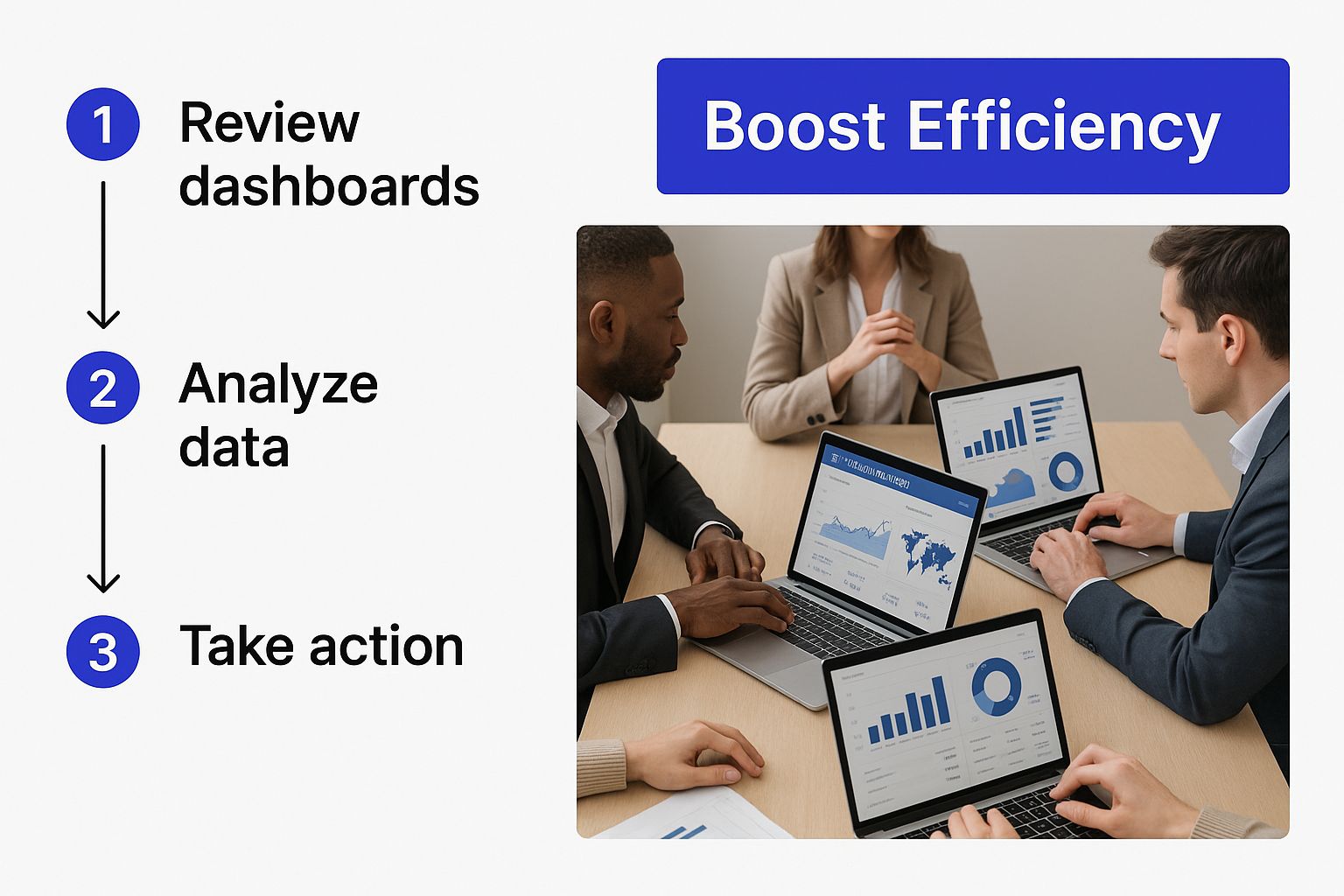Let’s be honest, modern marketing can feel like organized chaos. You're juggling campaigns, budgets, creative assets, and team approvals all at once. If you’ve ever felt like you're herding cats just to get a project out the door, you’ve experienced the problem that Marketing Resource Management (MRM) was built to solve.
Think of it as the central nervous system for your entire marketing operation—the operational backbone that connects your people, processes, and technology.
So, What Exactly Is Marketing Resource Management?
At its heart, MRM is a way to get your entire marketing department on the same page. It’s a mix of smart strategy and the right software designed to manage everything from the initial spark of an idea to the final performance report.
The goal isn't just to track tasks. It's about getting rid of the frustrating bottlenecks, stopping wasteful spending, and letting your creative team actually be creative instead of getting buried in administrative busywork.
This isn't just a niche idea, either. The MRM market was valued at around $4.91 billion and is expected to grow at a 12.4% clip every year through 2030. That kind of growth tells you one thing: companies are getting serious about operational efficiency. You can dive deeper into this trend over at The Business Research Company.
The Core Pillars of Marketing Resource Management
A good MRM system doesn't just do one thing; it brings several critical functions together under one roof. Let's break down the key components that make it work.
A truly effective MRM platform is built on a few core pillars. Understanding these helps clarify what you should be looking for.
| Pillar | What It Solves |
|---|---|
| Strategic Planning & Budgeting | Aligns marketing spend with business goals and stops budget overruns. |
| Content & Asset Management | Creates a central library for all creative assets, so no one uses old logos again. |
| Collaboration & Workflow Automation | Replaces messy email chains with clear, automated approval processes. |
| Performance Analytics | Connects your spending and effort directly to campaign ROI. |
By weaving these functions together, an MRM system gives you a single, reliable source of information for your entire team.
Let's look at what each of these pillars solves in the real world:
- Strategic Planning and Budgeting: This is where you connect your marketing plans to your company's big-picture goals. It’s about making sure every dollar you spend is intentional and can be tracked against results, which helps you avoid those awkward "we're over budget" conversations.
- Content and Asset Management: Ever had a salesperson use an ancient, off-brand presentation? This pillar fixes that. It gives everyone a central, up-to-date hub for every image, video, logo, and brand guideline, ensuring consistency everywhere.
- Collaboration and Workflow Automation: Say goodbye to endless email threads for approvals. MRM tools automate the boring, repetitive parts of your workflow, like sending a design from the writer to the designer to the legal team. Projects just keep moving.
- Performance Analytics: This is the magic ingredient. MRM connects the dots between your operational data (like how much a campaign cost and how long it took) and your performance data (like leads and ROI). You get a crystal-clear, data-backed view of what's working and what's not.
The real power of MRM is in breaking down the silos that naturally form in busy marketing teams. When everyone is working from the same playbook, you get better collaboration, faster execution, and a much more consistent brand voice across every single channel.
Building Your MRM Operational Foundation
Let's get one thing straight: jumping into marketing resource management isn't about buying a shiny new piece of software. It’s about re-engineering your entire marketing operation from the ground up. I’ve seen teams fail because they skip the foundational work, and frankly, success hinges on what you do before you ever log into a new platform.
The very first thing you need to do is a brutally honest audit of your current marketing processes. Where do things grind to a halt? Is it waiting for approvals, trying to track down the right assets, or getting a simple budget sign-off? You have to pinpoint these specific bottlenecks.
Once you know where the pain is, you can set clear, measurable goals. Don't be vague. Aim for something concrete, like "reduce our campaign launch time by 20%" or "cut down the time we spend searching for assets by five hours a week." These are numbers you can actually track.
Get Your Team On Board
With your goals in hand, the next step is getting your stakeholders to buy in. This means you need to build a compelling business case that screams ROI. Frame the conversation around the metrics that leadership actually cares about: improved efficiency, tighter brand compliance, and more accurate budget tracking.
It’s also absolutely critical to appoint a dedicated project champion. This person will own the implementation, drive adoption among the team, and be the go-to contact for everything. Without a champion, even the most promising MRM initiatives tend to lose momentum and fizzle out.
I can't stress this enough: the most common failure point I see in MRM implementation isn't the technology. It's a lack of preparation. A clear plan and a dedicated champion are non-negotiable.
This is what you're aiming for—a team that can collaborate seamlessly on marketing dashboards and other key activities, which is exactly what a well-implemented MRM system makes possible.

Finally, you need to map out your ideal marketing workflows from start to finish. Think through every single step, from the initial campaign brief and content creation all the way to the final performance report.
A great tool for this is a quarterly planning template, which can help you structure these strategic initiatives within the new MRM framework. This detailed mapping ensures your new tool adapts to how your team works, not the other way around. It's a lot like creating a solid social media marketing strategy—the upfront planning is what dictates your long-term success.
Put an End to Chaos by Streamlining Workflows and Centralizing Your Assets

Let's be honest, marketing can get messy. When you have files scattered across different drives, endless email chains for approvals, and no single place to find the final version of anything, you’re not just inefficient—you’re risking your brand's consistency.
Effective marketing resource management is about moving past that chaos. It’s about creating a single, reliable hub for your entire team, transforming disconnected operations into a smooth, collaborative engine.
The first, and most crucial, step is getting all your marketing materials into one place. This is often done with a Digital Asset Management (DAM) system, which is just a fancy term for your team’s central library. Think of it: every logo, video file, sales deck, and brand guideline, all living in one spot. When everyone knows exactly where to find the latest, on-brand creative, you immediately stop the frustrating and damaging cycle of using outdated assets.
I've seen this work wonders for a global CPG brand. Their MRM platform lets their European team submit new packaging designs, which are then automatically sent to the legal team in North America for compliance checks. The system handles the entire handoff, tracks all the feedback, and archives the final, approved version—all without a single "just following up" email.
Automate Your Reviews and Approvals
A core benefit of a good MRM is automating the review and approval process—the very thing that so often grinds projects to a halt. Forget manually forwarding a social media graphic to a copywriter, then a designer, then a manager. You build a predefined workflow once, and you’re set.
This means the system automatically moves an asset from one person to the next as soon as it's approved. This doesn't just speed up your projects; it creates a crystal-clear audit trail showing who approved what and when. The impact is huge, which is why the MRM market is projected to hit nearly $12.72 billion by 2029. This growth is fueled by teams demanding better ways to collaborate and get work done efficiently. You can explore more data on this market growth and its drivers.
A well-designed approval workflow does more than just save time. It enforces brand compliance and accountability by making the process transparent and repeatable for every single project.
Get a Real-Time View of Every Project
Beyond managing assets and approvals, a powerful MRM gives you a bird's-eye view of all ongoing projects and, just as importantly, your team's workload.
Imagine a marketing manager gearing up for a big, multi-channel product launch. With a quick glance, they can see exactly where everything stands:
- Email Campaign: The copy is good to go, but the design is still waiting for feedback.
- Social Media: Video assets are finished, but the ad copy is still being drafted.
- Website Banners: The design team is swamped and can't start on this for another three days.
This kind of real-time visibility lets you spot bottlenecks before they become full-blown crises. You can proactively reallocate resources, adjust deadlines, or bring in freelance help to ensure every deliverable stays on track and your team isn't burning out.
Using Performance Data for Smarter Decisions
A good marketing resource management (MRM) platform is far more than just a fancy organizational tool. Think of it as a goldmine of performance data. The real magic isn't just in seeing a historical record of what you did; it's about understanding what truly worked, what fell flat, and most importantly, why. This is where you draw a direct line from your team's operational efficiency straight to real business outcomes.
To really nail this, you have to look beyond the MRM system itself. The key is integrating your MRM with your CRM and analytics platforms. This breaks down the data silos and creates a single, unified view, letting you trace a campaign from its initial budget all the way to its direct impact on sales revenue.
Unifying Your Data for Clearer Insights
Imagine tracking your marketing budget against your actual spend in real time. You notice a specific social media campaign is underperforming, while another one is absolutely crushing its KPI targets. Instead of waiting for a quarterly review to find this out, you can react instantly.
This is where the agility comes in. You can pull funds from the lagging campaign and pump them into the one that's delivering, maximizing your marketing ROI on the fly. It’s a dynamic, responsive way to manage your resources.
Of course, this requires a solid grasp of analytics. To get the most out of your performance data, you need to be comfortable with tools like Google Analytics. If you're looking to level up your skills, there are some fantastic guides out there for mastering Google Analytics that can help you connect the dots between your marketing activities and website performance.
What you’re seeing here is the beautiful intersection of strategy, operations, and analytics. A well-integrated system makes all of this visible and, more importantly, actionable.
Building Dashboards That Drive Action
Ultimately, the goal is to build insightful dashboards that tell a clear, compelling story. A great dashboard gives any stakeholder an immediate understanding of how marketing activities are contributing to core business objectives. It's no surprise that marketers are leaning more heavily on MRM solutions to pull actionable insights from the massive amounts of data they're collecting.
An effective dashboard doesn't just display data; it answers critical business questions. It should move past vanity metrics and clearly link marketing spend to lead generation, customer acquisition cost, and its overall contribution to revenue.
To make this happen, you absolutely must be tracking the right metrics. Our comprehensive guide on marketing performance metrics examples is a perfect starting point for defining your own KPIs and building dashboards that actually mean something to your business.
Navigating Common MRM Implementation Pitfalls

Rolling out a new marketing resource management system is a huge operational undertaking, and I’ve seen firsthand that it’s rarely a simple plug-and-play scenario. Many teams hit roadblocks, not because the software is bad, but because they completely underestimate the human side of the equation. It's a change management challenge more than a tech one.
One of the most frequent stumbles I see is poor user adoption. You can sink a ton of money into the fanciest MRM platform out there, but if your team finds it clunky or just doesn't get why they should use it, it’ll quickly become expensive shelfware. This is what happens when training is a one-off webinar instead of an ongoing process, or when people aren't held accountable for actually recording their data consistently.
Another classic mistake is picking a system that's way too complex for your team's real, day-to-day needs. It’s easy to get wowed by a long list of features during a sales demo, but a bloated tool full of functions you’ll never touch just creates confusion and slows everyone down. Simplicity often wins.
Steering Clear of Common Obstacles
So, how do you avoid these traps? It’s all about being proactive and strategic. Instead of a massive, overwhelming "big bang" launch, try a phased rollout. This approach gives your team time to adapt in stages.
Start by solving your biggest headaches first. For instance, if your digital assets are a chaotic mess, begin by using the MRM just to centralize and tag your creative files. Once everyone is comfortable with that, you can move on to automating more complex approval workflows.
The real secret to a successful implementation is solid change management. You have to clearly and repeatedly communicate the ‘why’ behind the new system, framing it around how it makes each person’s job easier, not harder.
Finally, whatever you do, don't neglect integrations. A disconnected MRM is almost useless. It must talk to the other critical tools in your marketing tech stack, like your CRM or project management software. For example, if you automate your social media, that system needs to sync with your MRM. You can explore how powerful social media automation tools fit into the bigger picture to understand why these connections are so vital. If you fail to plan for this, you just end up with new data silos, which defeats the entire purpose of getting a unified system in the first place.
Alright, let's clear up some of the common questions that pop up around marketing resource management. Even when you get the big picture, the details can be a little fuzzy. I've heard these a few times, so let's tackle them head-on.
So, What’s the Real Difference Between MRM and a Project Management Tool?
This is easily the most frequent point of confusion, and it’s a fair question. Plenty of teams rely on project management tools like Asana or Trello to track tasks, and they're great for that. But an MRM is built for the specific, often messy, world of marketing operations.
Think of it like this: your project management tool is fantastic at telling you if a task got done. An MRM tells you the whole story—how much that task cost, which approved brand assets were used, who signed off on it, and ultimately, how it performed against its goals.
MRMs are built with features that general project tools just don't have, like:
- Digital Asset Management (DAM): A central, single source of truth for all your creative files. No more "final_final_v3.jpg."
- Budget and Financial Planning: The ability to tie every dollar spent directly to a campaign or marketing activity.
- Advanced Creative Proofing: Streamlined review and approval cycles built right in, so you can ditch those endless email chains.
- Performance Analytics: Tools to actually measure your marketing ROI, not just task completion.
How Do I Know if My Company Actually Needs an MRM?
You'll feel it before you can name it. If your team seems to be constantly fighting operational fires instead of doing creative, strategic work, that’s a huge sign.
The real tipping point is when your team spends more time in status update meetings and navigating administrative red tape than they do creating. That lost time is a direct hit to your marketing department’s real value.
Look for the tell-tale signs. Are there brand inconsistencies cropping up across different channels? Is tracking your marketing spend a constant headache? Does your team waste time hunting for the latest, approved version of a logo or ad? If you're nodding along to a few of these, it's probably time to start exploring an MRM solution.
Can a Small Business Really Benefit From This?
Absolutely. There's a lingering myth that MRM is just for huge enterprises with massive teams and budgets, but that’s an outdated view. Today’s MRM platforms are often modular and come with scalable pricing, making them a perfect fit for small and medium-sized businesses (SMBs).
Honestly, the impact can be even greater for an SMB. When you have a smaller team and a tighter budget, every single resource has to count. An MRM helps a small team punch above its weight by automating manual processes, locking in brand consistency as you grow, and making sure your limited funds are spent where they'll have the biggest impact.
My advice? Start small. You don't need to implement every feature at once. Identify your biggest pain point—maybe it's workflow automation or just getting your creative assets organized—and start there. You can always expand later.
Ready to stop the chaos and centralize your social media operations? PostSyncer provides a unified platform for content creation, scheduling, analytics, and collaboration. Streamline your workflows, maintain brand consistency, and free up your team to focus on what matters most. Start your 7-day free trial today.















